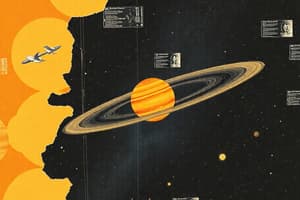Podcast
Questions and Answers
What is the main reason for the different phases of the moon?
What is the main reason for the different phases of the moon?
- The Earth is rotating on its axis.
- The Sun is moving around the Earth.
- The Moon is revolving around the Earth. (correct)
- The Earth is revolving around the Sun.
What force is responsible for keeping the planets in our solar system in their orbits?
What force is responsible for keeping the planets in our solar system in their orbits?
- Magnetism
- Gravity (correct)
- Electromagnetism
- Friction
What is the main reason for the change in seasons on Earth?
What is the main reason for the change in seasons on Earth?
- The Earth's orbit is elliptical.
- The Earth's axis is tilted. (correct)
- The Sun is moving closer to the Earth.
- The Earth's rotation is slowing down.
What occurs when the Moon passes directly between the Earth and the Sun?
What occurs when the Moon passes directly between the Earth and the Sun?
What is the term for the Moon's shadow falling on a specific region of the Earth during a lunar eclipse?
What is the term for the Moon's shadow falling on a specific region of the Earth during a lunar eclipse?
What is the primary factor that influences the shape of the Moon as seen from Earth?
What is the primary factor that influences the shape of the Moon as seen from Earth?
What is the primary force responsible for keeping the Moon in its orbit around Earth?
What is the primary force responsible for keeping the Moon in its orbit around Earth?
What occurs when the Earth passes directly between the Sun and the Moon?
What occurs when the Earth passes directly between the Sun and the Moon?
What is the main reason for the difference in the length of the day on Earth throughout the year?
What is the main reason for the difference in the length of the day on Earth throughout the year?
What is the term for the cyclical pattern of the Moon's appearance in the sky?
What is the term for the cyclical pattern of the Moon's appearance in the sky?
Flashcards
Why do we see lunar phases?
Why do we see lunar phases?
The Moon's orbit around the Earth.
What force holds planets in orbit?
What force holds planets in orbit?
Gravity.
Why do we have seasons?
Why do we have seasons?
The Earth's axis is tilted.
Moon between Earth and Sun?
Moon between Earth and Sun?
Signup and view all the flashcards
Darkest part of Moon's shadow?
Darkest part of Moon's shadow?
Signup and view all the flashcards
What shapes the Moon's appearance?
What shapes the Moon's appearance?
Signup and view all the flashcards
What force keeps the Moon in orbit?
What force keeps the Moon in orbit?
Signup and view all the flashcards
Earth between Sun and Moon?
Earth between Sun and Moon?
Signup and view all the flashcards
Why does daylight duration change?
Why does daylight duration change?
Signup and view all the flashcards
What is the moon's repeating pattern?
What is the moon's repeating pattern?
Signup and view all the flashcards
Study Notes
Earth-Sun-Moon System
- The Earth, Sun, and Moon are part of a system that shows cyclic patterns of lunar phases, eclipses, and seasons.
- The model of the Earth-sun-moon system helps to describe these patterns.
Gravity in the Solar System
- Gravity plays a role in the motions within galaxies and the solar system.
- A model can be developed to describe the role of gravity in these motions.
Analyzing the Solar System
- The solar system can be analyzed to understand the relationships between the Earth, Sun, and Moon.
- This analysis can help to identify patterns and phenomena, such as lunar phases, eclipses, and seasons.
Earth-Sun-Moon System
- The Earth, Sun, and Moon are part of a system that shows cyclic patterns of lunar phases, eclipses, and seasons.
- The model of the Earth-sun-moon system helps to describe these patterns.
Gravity in the Solar System
- Gravity plays a role in the motions within galaxies and the solar system.
- A model can be developed to describe the role of gravity in these motions.
Analyzing the Solar System
- The solar system can be analyzed to understand the relationships between the Earth, Sun, and Moon.
- This analysis can help to identify patterns and phenomena, such as lunar phases, eclipses, and seasons.
Studying That Suits You
Use AI to generate personalized quizzes and flashcards to suit your learning preferences.




